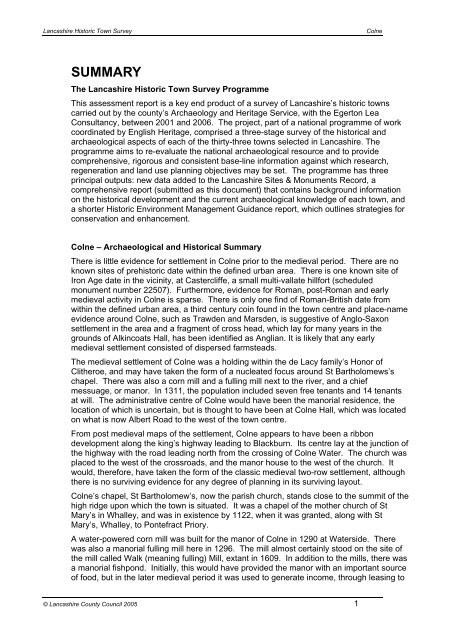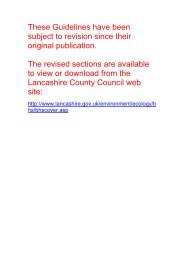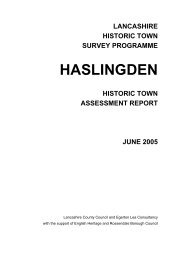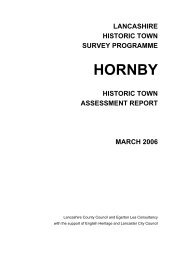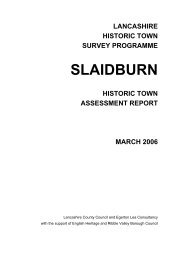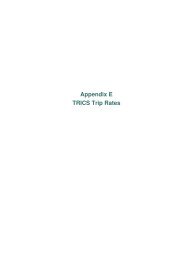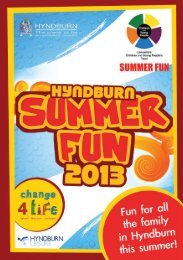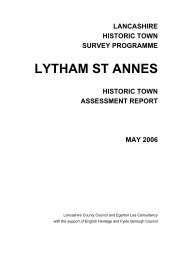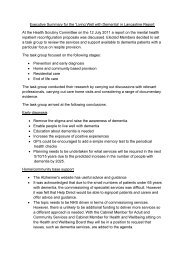Colne - Lancashire County Council
Colne - Lancashire County Council
Colne - Lancashire County Council
You also want an ePaper? Increase the reach of your titles
YUMPU automatically turns print PDFs into web optimized ePapers that Google loves.
<strong>Lancashire</strong> Historic Town Survey<strong>Colne</strong>SUMMARYThe <strong>Lancashire</strong> Historic Town Survey ProgrammeThis assessment report is a key end product of a survey of <strong>Lancashire</strong>’s historic townscarried out by the county’s Archaeology and Heritage Service, with the Egerton LeaConsultancy, between 2001 and 2006. The project, part of a national programme of workcoordinated by English Heritage, comprised a three-stage survey of the historical andarchaeological aspects of each of the thirty-three towns selected in <strong>Lancashire</strong>. Theprogramme aims to re-evaluate the national archaeological resource and to providecomprehensive, rigorous and consistent base-line information against which research,regeneration and land use planning objectives may be set. The programme has threeprincipal outputs: new data added to the <strong>Lancashire</strong> Sites & Monuments Record, acomprehensive report (submitted as this document) that contains background informationon the historical development and the current archaeological knowledge of each town, anda shorter Historic Environment Management Guidance report, which outlines strategies forconservation and enhancement.<strong>Colne</strong> – Archaeological and Historical SummaryThere is little evidence for settlement in <strong>Colne</strong> prior to the medieval period. There are noknown sites of prehistoric date within the defined urban area. There is one known site ofIron Age date in the vicinity, at Castercliffe, a small multi-vallate hillfort (scheduledmonument number 22507). Furthermore, evidence for Roman, post-Roman and earlymedieval activity in <strong>Colne</strong> is sparse. There is only one find of Roman-British date fromwithin the defined urban area, a third century coin found in the town centre and place-nameevidence around <strong>Colne</strong>, such as Trawden and Marsden, is suggestive of Anglo-Saxonsettlement in the area and a fragment of cross head, which lay for many years in thegrounds of Alkincoats Hall, has been identified as Anglian. It is likely that any earlymedieval settlement consisted of dispersed farmsteads.The medieval settlement of <strong>Colne</strong> was a holding within the de Lacy family’s Honor ofClitheroe, and may have taken the form of a nucleated focus around St Bartholomews’schapel. There was also a corn mill and a fulling mill next to the river, and a chiefmessuage, or manor. In 1311, the population included seven free tenants and 14 tenantsat will. The administrative centre of <strong>Colne</strong> would have been the manorial residence, thelocation of which is uncertain, but is thought to have been at <strong>Colne</strong> Hall, which was locatedon what is now Albert Road to the west of the town centre.From post medieval maps of the settlement, <strong>Colne</strong> appears to have been a ribbondevelopment along the king’s highway leading to Blackburn. Its centre lay at the junction ofthe highway with the road leading north from the crossing of <strong>Colne</strong> Water. The church wasplaced to the west of the crossroads, and the manor house to the west of the church. Itwould, therefore, have taken the form of the classic medieval two-row settlement, althoughthere is no surviving evidence for any degree of planning in its surviving layout.<strong>Colne</strong>’s chapel, St Bartholomew’s, now the parish church, stands close to the summit of thehigh ridge upon which the town is situated. It was a chapel of the mother church of StMary’s in Whalley, and was in existence by 1122, when it was granted, along with StMary’s, Whalley, to Pontefract Priory.A water-powered corn mill was built for the manor of <strong>Colne</strong> in 1290 at Waterside. Therewas also a manorial fulling mill here in 1296. The mill almost certainly stood on the site ofthe mill called Walk (meaning fulling) Mill, extant in 1609. In addition to the mills, there wasa manorial fishpond. Initially, this would have provided the manor with an important sourceof food, but in the later medieval period it was used to generate income, through leasing to© <strong>Lancashire</strong> <strong>County</strong> <strong>Council</strong> 2005 1


